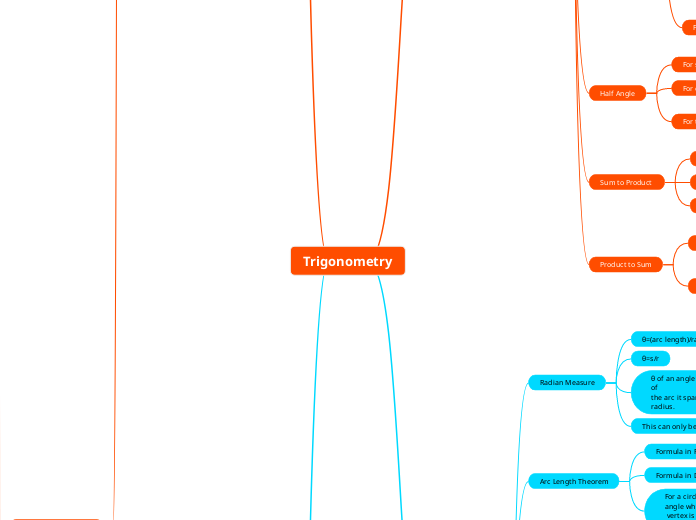przez Cristopher M 1 rok temu
201
Trigonometry

przez Cristopher M 1 rok temu
201

Więcej takich
Always write as ordered pairs when is more than one solution)
x=(0,2π)
k is any integer
One should know their angles and how to identify when to stop due to restrictions.
Helps you find the solutions as requested
θ+2kπ
0+2kπ
cosθ=1
θ=0
cosθ=1, when ,0≤ θ ≤2π
Observe the restrictions
See what function is being used
x=coty y=cot^(-1)x arccot
cot^(-1) θ
Properties
x/y
any θ
cotθ=x/y
Since radius is not needed to find cotangent, the equation is the same in all kinds of circles
cot
cos/sin
1/tan
0≤y≤π, y≠ π/2
x=secy y=sec^(-1)x arcsec
sec^(-1) θ
1/x
input
any θ
cscθ=r/x
Since radius is more than one, the result is r divided by x
cscθ=1/x
Since in a unit circle radius is one, the result is one over x
sec
1/cos
-π/2≤y≤π/2, y≠0
|x|≥1
x=cscy y=csc^(-1)x arccsc
csc^(-1) θ
all real numbers greater than or equal to 1 or less than or equal to -1
All real numbers except integer multiples of π
1/y
Any θ that does not produce division by zero
2√3/3
√2
2
Value Within Points
y≠0
cscθ=r/y
Since radius is more than one, radius should be divided by y
In a unit circle
cscθ=1/y
Since in a unit circle the radius is one, the result is one over y
cscθ
1/sinθ
-π/2
x=tany y=tan^(-1)x arctan
tan^(-1) θ
All real numbers
All real numbers except odd integeres multiples of π/2
y/x
any θ that does not produce division by zero
Measurement
Undefined
√3
pi/4
√3/3
Associates with the ratio of the y-coordinate to the x-coordinate)
Value within points
x≠0
tanθ=x/y
Since radius is not neded to find tangent, the equation is the same in all kind of circles
tanθ
sinθ/cosθ
[0,π]
x=cosy y=cos^(-1)x arccos
cos^(-1) θ
x
In Different Circles
cosθ=x/r
Since the radius is more than one, x should be divided by r
cosθ=x/1
Since in a unit circle the radius, or hypotenuse, is one, the result is x
Associates each angle with the horizontal coordinate (x-coordinate)
cos
Inverse
[-π/2,π/2]
x=siny y=sin^(-1)x arcsin
sin^(-1) θ
Properties
Range
[-1,1]
Domain
All Real Numbers
Output
y
Input
Measurements
360
2π
-1
270
3π/2
180
π
1
90
π/2
√3/2
60
π/3
√2/2
45
π/4
1/2
30
π/6
0
Value within Points
In a Different Circles
sinαθ=y/r
Since the radius is more than one, y should be divided by r
In a Unit Circle
sinθ= y/1
Since in a unit circle the radius, or hypotenuse, is one, the result is y
Asoociates each angle with the vertical coordinate (y-coordinate)
sin
θ
γ
β
α
Horizontal Shift: ϕ/ω
Period: T=2π/ω
A is amplitude, ω is omega, φ is phi
f ( x )= A sin ( ωx−φ ) + B= A sin (ω (x− φ/ω ) )+ B
a is the vertical stretch/compression b is the Horizontal stretch/compression h is the horizontal shift and k is the vertical shift
g(x)=af(b(x-h))+k
Their Period is π
θ+πk=θ
Their Period is 2π
θ+2πk=θ
C=360
C=2π
s=(θ/360)2πr
s=θr
cosα-cosβ=-2(sin (α+β)/2) (sin (α-β)/2)
cosα+cosβ=2(cos (α+β)/2) (cos (α-β)/2)
sinα-sinβ=2(sin (α-β)/2) (cos (α+β)/2)
sinα+sinβ=2(sin (α+β)/2) (cos (α-β)/2)
sinα cosβ=1/2[sin(α+β)-sin(α-β)]
cosα cosβ=1/2[cos(α-β)+cos(α+β)]
sinα sinβ=1/2[cos(α-β)-cos(α+β)]
tan ∝/2=(1-cos∝)/(sin∝)
tan ∝/2=±√((1-cos∝)/(1+cos∝))
cos ∝/2=±√((1+cos∝)/2)
sin ∝/2=±√((1-cos∝)/2)
tan^2 θ=(1-cos(2θ))/(1+cos(2θ))
tan(2θ)=2tanθ/(1-tanθ)
cos^2 θ=(1+cos(2θ))/2
cos(2θ)=2cos^2 θ-1
cos(2θ)=1-2sin^2 θ
cos(2θ)=cos^2 θ+sin^2 θ
sin^2 θ=1-cos(2θ)/2
sin(2θ)=2sinθcosθ
tan(α-β)=(tanα - tanβ)/(1+(tanα tanβ) )
tan(α+β)=(tanα + tanβ)/(1-(tanα tanβ) )
sin(a-b)=sina cosb-cosa sinb
sin(a+b)=sina cosb+cosa sinb
cos(a-b)=cosa cosb+sina sinb
cos(a+b)=cosa cosb-sina sinb